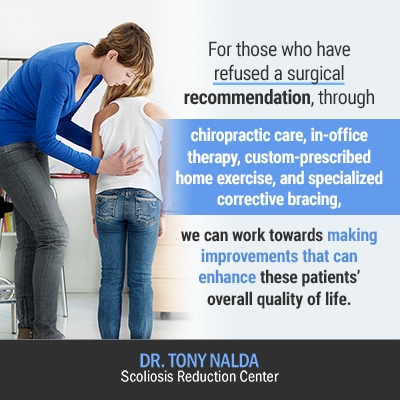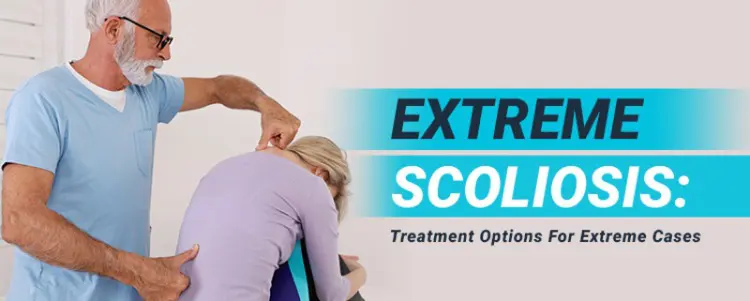There are many different types of scoliosis a person can develop, some with a known cause and some without. While scoliosis can develop at any age, it’s most commonly diagnosed during adolescence and develops across a wide severity spectrum. Keep reading to find out which condition-characteristic classifies it as mild, moderate, severe, or very severe.
A diagnosis of ‘extreme scoliosis’ means the condition is very severe. The main characteristic that determines condition severity is known as ‘Cobb angle’, which is a measurement of how far out of alignment a scoliotic spine is; this information helps guide the treatment process moving forward.
While many people refer to very-severe scoliosis cases as ‘extreme’, I prefer the term ‘very severe’, which is the term we’ll use for the bulk of the article. Before we move on to discussing the two main treatment options for very severe cases, let’s first explore very-severe scoliosis in general terms, and different degrees of scoliosis.
Very-Severe Scoliosis
Scoliosis is not a simple condition. In fact, every condition is as unique as the patient themselves, and scoliosis also affects people very differently; part of the reason for this is that scoliosis has varying levels of severity.
As the reality of living with the condition will differ from one patient to the next, that’s why it’s so important that treatment plans are customized to address the specific needs of each patient and their individual condition. There is no one-size-fits-all general approach to scoliosis treatment, and very-severe scoliosis is no exception.
When it comes to treatment options for scoliosis, there are two main approaches to choose between: chiropractic-centered and traditional.
For those choosing the latter, traditional treatment methods for very-severe scoliosis almost always funnel patients towards spinal-fusion surgery.
While all forms of scoliosis are progressive, meaning it’s in the condition’s nature to get worse over time, some forms are more likely to progress, and progress faster, than others. When it comes to very-severe scoliosis, we are talking about large abnormal spinal curvatures that carry a 90-percent risk of progression.
It’s this high risk of progression that leads orthopedic doctors, who favor the traditional-treatment route, to so commonly recommend surgery, but it’s also why it’s so important to choose a treatment approach wisely; different types of treatment offer patients very different outcomes.
If you or a loved one is dealing with very-severe scoliosis, it’s not uncommon to feel pressured into costly and invasive surgery, or because the scoliosis is very severe, you might feel that the extremity of the condition might warrant an invasive response. The truth is there are other effective treatment options, outside of surgery, available for those facing very-severe scoliosis.
Now that we have talked about very-severe scoliosis in general terms, let’s move on to the specifics of how a condition is classified on its severity scale.
Different Degrees of Scoliosis
As mentioned earlier, there are different degrees of scoliosis, in terms of severity and curvature size.
As scoliosis is an abnormal sideways curvature of the spine that includes rotation, and is progressive in nature, scoliosis is not a static condition; curvatures will get larger over time, if left untreated, and virtually every case will get worse at some point.
When a patient is diagnosed with scoliosis, their condition is classified as mild, moderate, severe, or very severe. The main piece of information that guides this classification process is known as ‘Cobb angle’
A patient’s Cobb angle is a measurement obtained via X-ray that draws intersecting lines from the tops and bottoms of the most-tilted vertebrae (bones of the spine) of the curvature. The larger the Cobb angle, the larger the abnormal curvature is, and the more severe the condition is considered.
- Mild scoliosis: Cobb angle measurement of between 10 and 25 degrees
- Moderate scoliosis: Cobb angle measurement of between 25 and 40 degrees
- Severe scoliosis: Cobb angle measurement of 40+ degrees
- Very-severe scoliosis: Cobb angle measurement of 80+ degrees
As you can see, there is a huge range of curvature degrees, and generally speaking, the more severe a condition is, the more likely it is to produce noticeable symptoms such as postural changes and pain (in adults).
In reality, as scoliosis progresses, the traditional approach to treatment can push patients towards spinal-fusion surgery; this is the case with various severity levels, but is especially true once a condition has progressed into the severe and very-severe stage.
This is because this approach includes a lot of watching and waiting while the condition is mild and doesn’t involve proactive treatment until after the scoliosis has progressed significantly.
When following the traditional model, once a patient’s scoliosis has, inevitably, moved into the higher stages of progression, traditional orthopedic doctors will likely use bracing to try and slow down progression, which can be effective for a time, but eventually, that patient will likely reach a point where surgery is recommended as their best option.
I feel that even for severe-scoliosis patients, I believe patients should research all of their options. Before we move onto the chiropractic-centered approach that I believe in, let’s take a moment to think about what it’s like to live with very-severe scoliosis.
Living with Very-Severe Scoliosis
Oftentimes, people living with very-severe scoliosis choose surgery because as an incurable condition, they feel that controlling progression is the means by which it’s managed; however, what many people don’t realize is that once a person’s scoliosis has reached the very-severe stage, surgery can’t guarantee that continued progression won’t occur.
A patient’s Cobb angle can continue to increase even after a patient has reached skeletal maturity and even after they have had spinal-fusion surgery.
In addition, the one form of active treatment, other than surgery, that the traditional approach uses is scoliosis bracing, and once scoliosis is very severe, the design of traditional bracing makes it ineffective as its goal is to merely hold a curve in place, rather than actually correct it.

For many patients, life with very-severe scoliosis can be more difficult and challenging. Again, while every case is different, it can cause daily and chronic pain, especially in adults, and it can place limits on a patient’s lifestyle and activity level.
In addition, there is the emotional component of being diagnosed with a very-severe progressive condition. People with very-severe scoliosis tend to be self-conscious of their posture, gait, and the way their clothes hang on their bodies. This is because the main changes that scoliosis causes, in terms of physical appearance, are driven by the uneven forces at work within the condition and the asymmetrical affect it can have on the body.
People dealing with these issues can be particularly sensitive to how others see and treat them, potentially leading to negative self-image and depression.
While life with very-severe scoliosis doesn’t always carry these negative outcomes, it does tend to carry a heightened emotional component that some patients struggle to deal with. Feelings of a loss of control can be overwhelming for these patients, and when these same patients are presented with invasive surgery as the main treatment option available to them, this can exacerbate those feelings of powerlessness, especially if the outcome is not what they expected.
In the majority of my very-severe scoliosis patients, they have researched their options, consulted with a surgeon, and chosen not to follow the surgical recommendation.
I am here to tell patients that regardless of condition severity, it’s never too late to start proactive treatment. Part of the reason I wrote Scoliosis Hope was to educate patients, and their families, on another treatment option available to them that can offer a different outcome: a functional chiropractic-centered approach.
Chiropractic-Centered Approach for Very-Severe Scoliosis
It’s natural for patients with very-severe scoliosis to feel that their condition has progressed beyond the scope of nonsurgical treatment options, but I’m here to say that effective alternatives do indeed exist.
When scoliosis progresses into the severe and very-severe stage, treatment can be challenging for the patient. It involves a lot of commitment, dedication, and hard work, and in addition, it’s not a quick process. Patience is important, but once these patients see those first improvement results, the motivational force to keep moving forward is powerful.
While surgery can offer patients a seemingly-quick result of a straighter spine, there are less-invasive treatment options available that can offer a different outcome, without the risks and side effects that spinal fusion is associated with.
In fact, there have been several studies over the years that highlight the poor outcomes that many scoliosis patients are faced with post-surgery, with many reporting an increase in related back pain and a significant loss of flexibility.
In many cases, subsequent surgeries are needed because once a spine is fused, there is no going back; the only recourse for those unhappy with the results or who develop a complication is more surgery.
There is also the longevity of the hardware used to consider. As spinal fusion involves attaching rods to the spine with screws to hold it in position while the separate vertebrae continue to fuse into one solid bone, that hardware has a lifespan of its own, and once it fails, there is only one way to remove or replace it: more surgery.
The bottom line is that spinal-fusion surgery can never guarantee to fully reduce scoliosis-related pain, stop a curvature from further progression, and/or make all disfiguring effects of the condition disappear. These are things that a lot of patients expect, and sadly, this is what I hear from a lot of patients who come to see me after having had spinal-fusion: their expectations of spinal-fusion surgery were not aligned with the reality of its outcome.
Scoliosis Reduction Center® Approach
Here at the Scoliosis Reduction Center®, I see the results that severe-scoliosis patients, who have refused surgery or decided to forgo a surgical recommendation, can achieve through a strong commitment to improvement and my functional chiropractic-centered treatment approach.
I work closely with each patient, and their families, to make sure they have the support they need throughout the entire course of treatment. I customize plans designed for each patient to ensure the specifics of their condition are being addressed, and those plans involve integrating multiple scoliosis-specific treatment disciplines.
Unlike the traditional approach that has slowing/stopping progression as its main treatment goal, here at the Center, our ultimate goal with very-severe scoliosis patients is stabilization and correction, which addresses the underlying structural nature of the condition.

For those who have refused a surgical recommendation, through chiropractic care, in-office therapy, custom-prescribed home exercise, and specialized corrective bracing, we can work towards making improvements that can enhance these patients’ overall quality of life.
First and foremost, we want to impact the condition on a structural level with targeted chiropractic adjustments, and then we work on sustaining that curvature reduction by increasing core strength to keep the muscles that support and stabilize the spine strong and loose.
If you or someone you care about is facing the difficult decision of how to treat very-severe scoliosis, it’s important you understand that not all roads have to lead to surgery and that there are other effective treatment options available.
As different treatment approaches carry different outcomes, I want to be clear that patients need to be realistic about expectations and make sure that whatever their choice, it’s aligned with reality.
My approach might take some time, hard work, and commitment, but it can help patients find improvement through a less-invasive and costly means than spinal-fusion surgery.
Conclusion
Although scoliosis can start out as mild, it’s bound to get worse over time, especially if left untreated. The longer a condition is left to progress unimpeded without proactive treatment, the more likely it is to reach the severe and very-severe stage of progression.
While the traditional treatment approach recommending spinal-fusion surgery has been the dominant choice for many years, there is a lot to be said for newer approaches that incorporate advancements made in the understanding and treatment of the condition.
Here at the Scoliosis Reduction Center®, the approach we offer our patients is customized, effective, functional and chiropractic-centered. We believe in empowering our patients by engaging with them throughout the treatment process and through their engagement with our proactive approach and the improvements they can experience: proving that it’s never too late to seek out nonsurgical treatment options.
Regardless of your treatment-approach choice, make sure you fully research all options available to ensure that the chosen method is aligned not only with the reality of its potential outcome, but also with your expectations and what you want from life moving forward.





